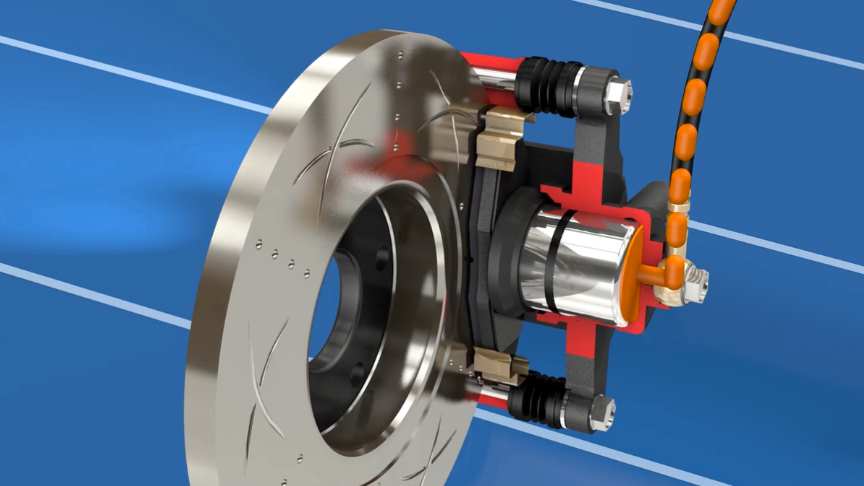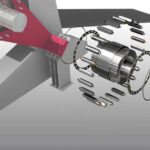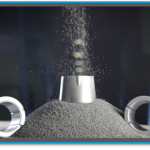Introduction
A brake is a device by means of which artificial frictional resistance is applied to a moving machine member, in order to retard or stop the motion of a machine. In the process of performing this function, the brake absorbs either kinetic energy of the moving member or potential energy given up by objects being lowered by hoists, elevators etc.
The energy absorbed by brakes is dissipated in the form of heat. This heat is dissipated in the surrounding air (or water which is circulated through the passages in the brake drum) so that excessive heating of the brake lining does not take place. The design or capacity of a brake depends upon the following factors :
1. The unit pressure between the braking surfaces,
2. The coefficient of friction between the braking surfaces,
3. The peripheral velocity of the brake drum
4. The projected area of the friction surfaces, and
5. The ability of the brake to dissipate heat equivalent to the energy being absorbed.
The major functional difference between a clutch and a brake is that a clutch is used to keep the driving and driven member moving together, whereas brakes are used to stop a moving member or to control its speed.
Energy Absorbed by a Brake
The energy absorbed by a brake depends upon the type of motion of the moving body. The motion of a body may be either pure translation or pure rotation or a combination of both translation and rotation. The energy corresponding to these motions is kinetic energy. Let us consider these motions as follows :
1. When the motion of the body is pure translation. Consider a body of mass (m) moving with a velocity v1 m / s. Let its velocity is reduced to v2 m / s by applying the brake. Therefore, the change in kinetic energy of the translating body or kinetic energy of translation,

This energy must be absorbed by the brake. If the moving body is stopped after applying the brakes, then v2 = 0, and

2. When the motion of the body is pure rotation. Consider a body of mass moment of inertia I (about a given axis) is rotating about that axis with an angular velocity ω1 rad / s. Let its angular velocity is reduced to ω2 rad / s after applying the brake. Therefore, the change in kinetic energy of the rotating body or kinetic energy of rotation,

This energy must be absorbed by the brake. If the rotating body is stopped after applying the brakes, then ω2 = 0, and

3. When the motion of the body is a combination of translation and rotation. Consider a body having both linear and angular motions, e.g. in the locomotive driving wheels and wheels of a moving car. In such cases, the total kinetic energy of the body is equal to the sum of the kinetic energies of translation and rotation.
∴ Total kinetic energy to be absorbed by the brake

Heat to be Dissipated during Braking
The energy absorbed by the brake and transformed into heat must be dissipated to the surrounding air in order to avoid excessive temperature rise of the brake lining. The upon the mass of the brake drum, the braking time and the heat dissipation capacity of the brake. The highest permissible temperatures recommended for different brake lining materials are given as follows :
1. For leather, fibre and wood facing = 65 – 70°C
2. For asbestos and metal surfaces that are slightly lubricated = 90 – 105°C
3. For automobile brakes with asbestos block lining = 180 – 225°C
Since the energy absorbed (or heat generated) and the rate of wear of the brake lining at a particular speed are dependent on the normal pressure between the braking surfaces, therefore it is an important factor in the design of brakes. The permissible normal pressure between the braking surfaces depends upon the material of the brake lining, the coefficient of friction and the maximum rate at which the energy is to be absorbed. The energy absorbed, or the heat generated is given by

where
μ = Coefficient of friction,
RN = Normal force acting at the contact surfaces, in newtons,
p = Normal pressure between the braking surfaces in N/m2,
A = Projected area of the contact surfaces in m2, and
v = Peripheral velocity of the brake drum in m/s.
The heat generated may also be obtained by considering the amount of kinetic or potential energies which is being absorbed. In other words,


In brakes, it is very difficult to precisely calculate the temperature rise. In preliminary design analysis, the product p.v is considered in place of temperature rise. The experience has also shown that if the product p.v is high, the rate of wear of brake lining will be high and the brake life will be low. Thus the value of p.v should be lower than the upper limit value for the brake lining to have reasonable wear life. The following table shows the recommended values of p.v as suggested by various designers for different types of service.


